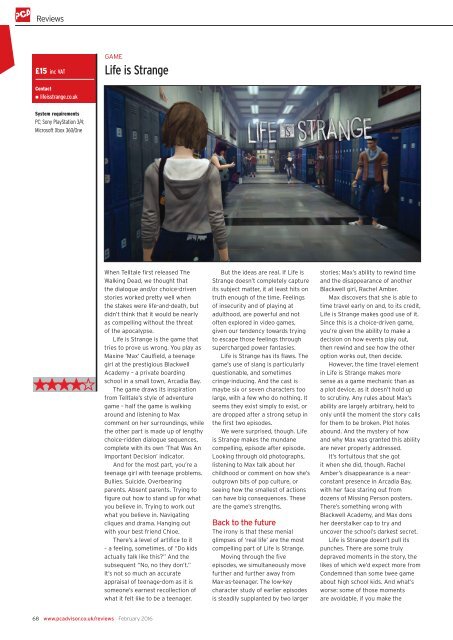Create successful ePaper yourself
Turn your PDF publications into a flip-book with our unique Google optimized e-Paper software.
Reviews<br />
£15 inc VAT<br />
GAME<br />
Life is Strange<br />
Contact<br />
• lifeisstrange.co.uk<br />
System requirements<br />
<strong>PC</strong>; Sony PlayStation 3/4;<br />
Microsoft Xbox 360/One<br />
When Telltale first released The<br />
Walking Dead, we thought that<br />
the dialogue and/or choice-driven<br />
stories worked pretty well when<br />
the stakes were life-and-death, but<br />
didn’t think that it would be nearly<br />
as compelling without the threat<br />
of the apocalypse.<br />
Life is Strange is the game that<br />
tries to prove us wrong. You play as<br />
Maxine ‘Max’ Caulfield, a teenage<br />
girl at the prestigious Blackwell<br />
Academy – a private boarding<br />
school in a small town, Arcadia Bay.<br />
The game draws its inspiration<br />
from Telltale’s style of adventure<br />
game – half the game is walking<br />
around and listening to Max<br />
comment on her surroundings, while<br />
the other part is made up of lengthy<br />
choice-ridden dialogue sequences,<br />
complete with its own ‘That Was An<br />
Important Decision’ indicator.<br />
And for the most part, you’re a<br />
teenage girl with teenage problems.<br />
Bullies. Suicide. Overbearing<br />
parents. Absent parents. Trying to<br />
figure out how to stand up for what<br />
you believe in. Trying to work out<br />
what you believe in. Navigating<br />
cliques and drama. Hanging out<br />
with your best friend Chloe.<br />
There’s a level of artifice to it<br />
– a feeling, sometimes, of “Do kids<br />
actually talk like this?” And the<br />
subsequent “No, no they don’t.”<br />
It’s not so much an accurate<br />
appraisal of teenage-dom as it is<br />
someone’s earnest recollection of<br />
what it felt like to be a teenager.<br />
But the ideas are real. If Life is<br />
Strange doesn’t completely capture<br />
its subject matter, it at least hits on<br />
truth enough of the time. Feelings<br />
of insecurity and of playing at<br />
adulthood, are powerful and not<br />
often explored in video games,<br />
given our tendency towards trying<br />
to escape those feelings through<br />
supercharged power fantasies.<br />
Life is Strange has its flaws. The<br />
game’s use of slang is particularly<br />
questionable, and sometimes<br />
cringe-inducing. And the cast is<br />
maybe six or seven characters too<br />
large, with a few who do nothing. It<br />
seems they exist simply to exist, or<br />
are dropped after a strong setup in<br />
the first two episodes.<br />
We were surprised, though. Life<br />
is Strange makes the mundane<br />
compelling, episode after episode.<br />
Looking through old photographs,<br />
listening to Max talk about her<br />
childhood or comment on how she’s<br />
outgrown bits of pop culture, or<br />
seeing how the smallest of actions<br />
can have big consequences. These<br />
are the game’s strengths.<br />
Back to the future<br />
The irony is that these menial<br />
glimpses of ‘real life’ are the most<br />
compelling part of Life is Strange.<br />
Moving through the five<br />
episodes, we simultaneously move<br />
further and further away from<br />
Max-as-teenager. The low-key<br />
character study of earlier episodes<br />
is steadily supplanted by two larger<br />
stories: Max’s ability to rewind time<br />
and the disappearance of another<br />
Blackwell girl, Rachel Amber.<br />
Max discovers that she is able to<br />
time travel early on and, to its credit,<br />
Life is Strange makes good use of it.<br />
Since this is a choice-driven game,<br />
you’re given the ability to make a<br />
decision on how events play out,<br />
then rewind and see how the other<br />
option works out, then decide.<br />
However, the time travel element<br />
in Life is Strange makes more<br />
sense as a game mechanic than as<br />
a plot device, as it doesn’t hold up<br />
to scrutiny. Any rules about Max’s<br />
ability are largely arbitrary, held to<br />
only until the moment the story calls<br />
for them to be broken. Plot holes<br />
abound. And the mystery of how<br />
and why Max was granted this ability<br />
are never properly addressed.<br />
It’s fortuitous that she got<br />
it when she did, though. Rachel<br />
Amber’s disappearance is a nearconstant<br />
presence in Arcadia Bay,<br />
with her face staring out from<br />
dozens of Missing Person posters.<br />
There’s something wrong with<br />
Blackwell Academy, and Max dons<br />
her deerstalker cap to try and<br />
uncover the school’s darkest secret.<br />
Life is Strange doesn’t pull its<br />
punches. There are some truly<br />
depraved moments in the story, the<br />
likes of which we’d expect more from<br />
Condemned than some twee game<br />
about high school kids. And what’s<br />
worse: some of those moments<br />
are avoidable, if you make the<br />
68 www.pcadvisor.co.uk/reviews February 2016






